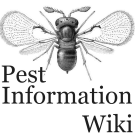Publications for:
pest = Botrytis cinerea
crop = Rosa (crop)
found 21 publications:2020
Global analysis of the AP2/ERF gene family in rose (Rosa chinensis) genome unveils the role of RcERF099 in Botrytis resistanceBMC Plant Biology (2020) 20 (533)
publishers website - pestinfo wiki
RcMYB84 and RcMYB123 mediate jasmonate-induced defense responses against Botrytis cinerea in rose (Rosa chinensis)
The Plant Journal (2020) 103 (6), 1839-1849
publishers website - pestinfo wiki
2019
Genome-wide characterization of the rose (Rosa chinensis) WRKY family and role of RcWRKY41 in gray mold resistanceBMC Plant Biology (2019) 19 (522)
publishers website - pestinfo wiki
Characterization of Botrytis cinerea from commercial cut flower roses
Plant Disease (2019) 103 (7), 1577-1583
publishers website - pestinfo wiki
2017
Postharvest evaluation of natural coatings and antifungal agents to control Botrytis cinerea in Rosa sp.Phytoparasitica (2017) 45 (1), 9-20
publishers website - pestinfo wiki
2009
Use of 1-methylcyclopropene for the control of Botrytis cinerea on cut flowersPhytopathologia Mediterranea (2009) 48 (2), 253-261
pestinfo wiki
2006
Relationships of microclimatic variables to colonization of rose debris by Botrytis cinerea and the biocontrol agent Clonostachys roseaBiocontrol Science and Technology (2006) 16 (6), 619-630
publishers website - pestinfo wiki
2005
Survival of Botrytis cinerea as mycelium in rose crop debris and as sclerotia in soilFitopatologia Brasileira (2005) 30 (5), 516-521
publishers website - pestinfo wiki
2004
Use of methyl jasmonate for suppression of Botrytis rot in various cultivars of cut rose flowersPhytoparasitica (2004) 32 (2), 206-207
pestinfo wiki
2003
Gray mold severity and vase life of rose buds after pulsing with citric acid, salicylic acid, calcium sulfate, sucrose and silver thiosulfateFitopatologia Brasileira (2003) 28 (4), 380-385
publishers website - pestinfo wiki
2000
Effects of host and microbial factors on development of Clonostachys rosea and control of Botrytis cinerea in roseEuropean Journal of Plant Pathology (2000) 106 (5), 439-448
publishers website - pestinfo wiki
Relationships of aphid and mite infestations to control of Botrytis cinerea by Clonostachys rosea in rose (Rosa hybrida) leaves
Phytoparasitica (2000) 28 (1), 55-64
publishers website - pestinfo wiki
1999
Fenhexamid ('Teldor'), a new preparation for the control of Botrytis cinerea in various crops in IsraelPhytoparasitica (1999) 27 (2), 154-155
pestinfo wiki
1998
Biological control of Botrytis cinerea on cut roses at the post-harvest stageInternational Congress of Plant Pathology (1998) 7th meeting, section 5.2
pestinfo wiki
Biological control of Botrytis cinerea in residues and flowers of rose (Rosa hybrida)
Phytoparasitica (1998) 26 (1), 8-19
publishers website - pestinfo wiki
1997
Control of Botrytis cinerea in cut rose flowers by means of vapors of pyrimethanilPhytoparasitica (1997) 25 (3), p. 258
pestinfo wiki
Variation in pathogenicity and DNA polymorphism among Botrytis cinerea isolates sampled inside and outside a glasshouse
Plant Disease (1997) 81 (7), 781-786
publishers website - pestinfo wiki
1996
Relations between glasshouse climate and dry weight of petals, epicuticular wax, cuticle, pre-harvest flowering period and susceptibility to Botrytis cinerea of gerbera and rose flowersEuropean Journal of Plant Pathology (1996) 102 (3), 257-263
publishers website - pestinfo wiki
Effects of the production environment on the susceptibility of rose flowers to postharvest infection by Botrytis cinerea
Journal of the American Society for Horticultural Science (1996) 121 (2), 314-320
pestinfo wiki
1995
Influence of environmental conditions in a glasshouse on conidia of Botrytis cinerea and on post-harvest infection of rose flowersEuropean Journal of Plant Pathology (1995) 101 (2), 201-216
publishers website - pestinfo wiki
1990
Postharvest control of Botrytis cinerea infections on cut roses using fungistatic storage atmospheresJournal of the American Society for Horticultural Science (1990) 115 (1), 102-107
pestinfo wiki
